Remote Sensing Extraction Method of Tailings Ponds in Ultra-Low-Grade Iron Mining Area Based on Spectral Characteristics and Texture Entropy
Abstract
:1. Introduction
2. Materials
2.1. Study Area
2.2. Field Spectral Data
2.3. Remote Sensing Data
3. Methods
3.1. Extraction Method of Ultra-Low-Grade Iron-Related Objects Based on Spectral Characteristics
3.1.1. Spectral Characteristics of Tailings Pond
3.1.2. Design of Ultra-Low-Grade Iron-Related Objects Index
3.2. Distinguishing Tailings Pond from Stope Based on Texture Characteristics
4. Results and Discussion
4.1. Extraction of Ultra-Low-Grade Iron-Related Objects
4.2. Extraction of Tailings Pond
5. Conclusions
- (1)
- Based on spectral characteristics, ULIOI was designed to extract ultra-low-grade iron-related objects (i.e., tailings and iron ore) by using Landsat 8 OLI multi-spectral Bands 3, 4, 6 and 7. The extraction was realized with a threshold. This was the basis for the extraction of tailings ponds.
- (2)
- Based on texture characteristics, entropy was calculated to distinguish tailings ponds from stopes by using a Landsat 8 OLI panchromatic image. Texture characteristics of tailings ponds were more consistent, and the entropy value was smaller. Texture characteristics of the stope were more complicated, and the entropy value was greater. The entropy value in a 7 × 7 window size was selected to differentiate tailings ponds and stopes with the threshold of 2.4.
Author Contributions
Acknowledgments
Conflicts of Interest
References
- Sonter, L.J.; Barrett, D.J.; Soares-Filho, B.S.; Moran, C.J. Global demand for steel drives extensive land-use change in Brazil’s Iron Quadrangle. Glob. Environ. Chang. 2014, 26, 63–72. [Google Scholar] [CrossRef]
- Yellishetty, M.; Ranjith, P.G.; Tharumarajah, A. Iron ore and steel production trends and material flows in the world: Is this really sustainable? Resour. Conserv. Recycl. 2010, 54, 1084–1094. [Google Scholar] [CrossRef]
- Li, H.-M.; Li, L.-X.; Yang, X.-Q.; Cheng, Y.-B. Types and geological characteristics of iron deposits in China. J. Asian Earth Sci. 2015, 103, 2–22. [Google Scholar] [CrossRef]
- Zhang, Z.; Hou, T.; Santosh, M.; Li, H.; Li, J.; Zhang, Z.; Song, X.; Wang, M. Spatio-temporal distribution and tectonic settings of the major iron deposits in China: An overview. Ore Geol. Rev. 2014, 57, 247–263. [Google Scholar] [CrossRef]
- Shuaixing, S.; Ming, Z.; Ming, T.; Maohe, L. Recovery of phosphorite from coarse particle magnetic ore by flotation. Int. J. Miner. Process. 2015, 142, 10–16. [Google Scholar] [CrossRef]
- Li, L.X.; Li, H.M.; Wang, D.Z.; Liu, M.J.; Yang, X.Q.; Chen, J. Ore genesis and ore-forming age of the Tiemahabaqin ultra-low-grade iron deposit in Chengde, Hebei Province, China. Rock Miner. Anal. 2012, 31, 898–905. [Google Scholar]
- Ma, B.; Pu, R.; Wu, L.; Zhang, S. Vegetation Index Differencing for Estimating Foliar Dust in an Ultra-Low-Grade Magnetite Mining Area Using Landsat Imagery. IEEE Access 2017, 5, 8825–8834. [Google Scholar] [CrossRef]
- Cui, L.; Zhou, D. Environmental problems caused by ultra-low-grade magnetite exploitation and countermeasures. Resour. Environ. Eng. 2015, 29, 213–217. [Google Scholar]
- Coulibaly, Y.; Belem, T.; Cheng, L. Numerical analysis and geophysical monitoring for stability assessment of the Northwest tailings dam at Westwood Mine. Int. J. Min. Sci. Technol. 2017, 27, 701–710. [Google Scholar] [CrossRef]
- Stovern, M.; Rine, K.; Russell, M.; Felix, O.; King, M.; Saez, A.; Betterton, E. Development of a dust deposition forecasting model for mine tailings impoundments using in situ observations and particle transport simulations. Aeolian Res. 2015, 18, 155–167. [Google Scholar] [CrossRef]
- Hu, X.; Oommen, T.; Lu, Z.; Wang, T.; Kim, J.-W. Consolidation settlement of Salt Lake County tailings impoundment revealed by time-series InSAR observations from multiple radar satellites. Remote Sens. Environ. 2017, 202, 199–209. [Google Scholar] [CrossRef]
- Mohamed, M.H.; Wilson, L.D.; Headley, J.V.; Peru, K.M. Novel materials for environmental remediation of tailing pond waters containing naphthenic acids. Process Saf. Environ. Prot. 2008, 86, 237–243. [Google Scholar] [CrossRef]
- Zornoza, R.; Faz, Á.; Carmona, D.M.; Acosta, J.A.; Martínez-Martínez, S.; de Vreng, A. Carbon mineralization, microbial activity and metal dynamics in tailing ponds amended with pig slurry and marble waste. Chemosphere 2013, 90, 2606–2613. [Google Scholar] [CrossRef] [PubMed]
- Jucker Riva, M.; Daliakopoulos, I.N.; Eckert, S.; Hodel, E.; Liniger, H. Assessment of land degradation in Mediterranean forests and grazing lands using a landscape unit approach and the normalized difference vegetation index. Appl. Geogr. 2017, 86, 8–21. [Google Scholar] [CrossRef]
- Liou, Y.-A.; Nguyen, A.K.; Li, M.-H. Assessing spatiotemporal eco-environmental vulnerability by Landsat data. Ecol. Indic. 2017, 80, 52–65. [Google Scholar] [CrossRef]
- Jawak, S.D.; Luis, A.J. A Rapid Extraction of Water Body Features from Antarctic Coastal Oasis Using Very High-Resolution Satellite Remote Sensing Data. Aquat. Procedia 2015, 4, 125–132. [Google Scholar] [CrossRef]
- Schmid, T.; Koch, M.; DiBlasi, M.; Hagos, M. Spatial and spectral analysis of soil surface properties for an archaeological area in Aksum, Ethiopia, applying high and medium resolution data. CATENA 2008, 75, 93–101. [Google Scholar] [CrossRef]
- Muller, S.J.; van Niekerk, A. Identification of WorldView-2 spectral and spatial factors in detecting salt accumulation in cultivated fields. Geoderma 2016, 273, 1–11. [Google Scholar] [CrossRef]
- Su, H.; Wang, Y.; Xiao, J.; Li, L. Improving MODIS sea ice detectability using gray level co-occurrence matrix texture analysis method: A case study in the Bohai Sea. ISPRS J. Photogramm. Remote Sens. 2013, 85, 13–20. [Google Scholar] [CrossRef]
- Roberti de Siqueira, F.; Robson Schwartz, W.; Pedrini, H. Multi-scale gray level co-occurrence matrices for texture description. Neurocomputing 2013, 120, 336–345. [Google Scholar] [CrossRef]
- Pourghasemi, H.R.; Mohammady, M.; Pradhan, B. Landslide susceptibility mapping using index of entropy and conditional probability models in GIS: Safarood Basin, Iran. CATENA 2012, 97, 71–84. [Google Scholar] [CrossRef]
- Han, B.; Wu, Y. A novel active contour model based on modified symmetric cross entropy for remote sensing river image segmentation. Pattern Recognit. 2017, 67, 396–409. [Google Scholar] [CrossRef]
- Padmanaban, R.; Bhowmik, A.K.; Cabral, P.; Zamyatin, A.; Almegdadi, O.; Wang, S. Modelling Urban Sprawl Using Remotely Sensed Data: A Case Study of Chennai City, Tamilnadu. Entropy 2017, 19, 163. [Google Scholar] [CrossRef]
- Roy, D.P.; Kovalskyy, V.; Zhang, H.K.; Vermote, E.F.; Yan, L.; Kumar, S.S.; Egorov, A. Characterization of Landsat-7 to Landsat-8 reflective wavelength and normalized difference vegetation index continuity. Remote Sens. Environ. 2016, 185, 57–70. [Google Scholar] [CrossRef]
- FLAASH User’s Guide, Atmospheric Correction Module: QUAC and FLAASH User’s Guide, August 2009 ed.; ITT Visual Information Solutions: Boulder, CO, USA, 2009; p. 44.
- Xu, A.; Ma, B.; Li, X.; Wu, L. Spectral testing and quantitative inversion for dust of iron tailings on leaf. Remote Sens. Land Resour. 2017, 29, 164–169. [Google Scholar]
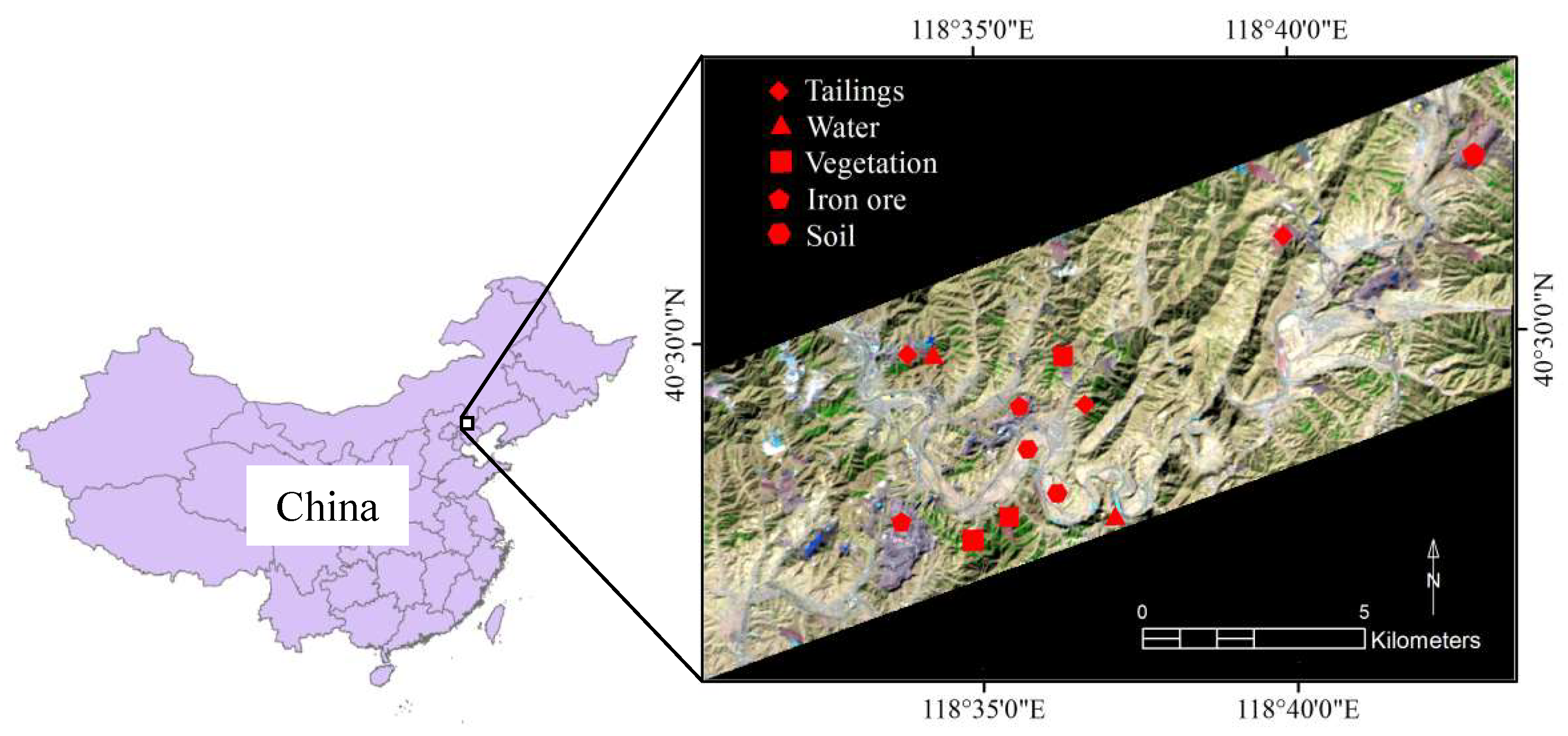
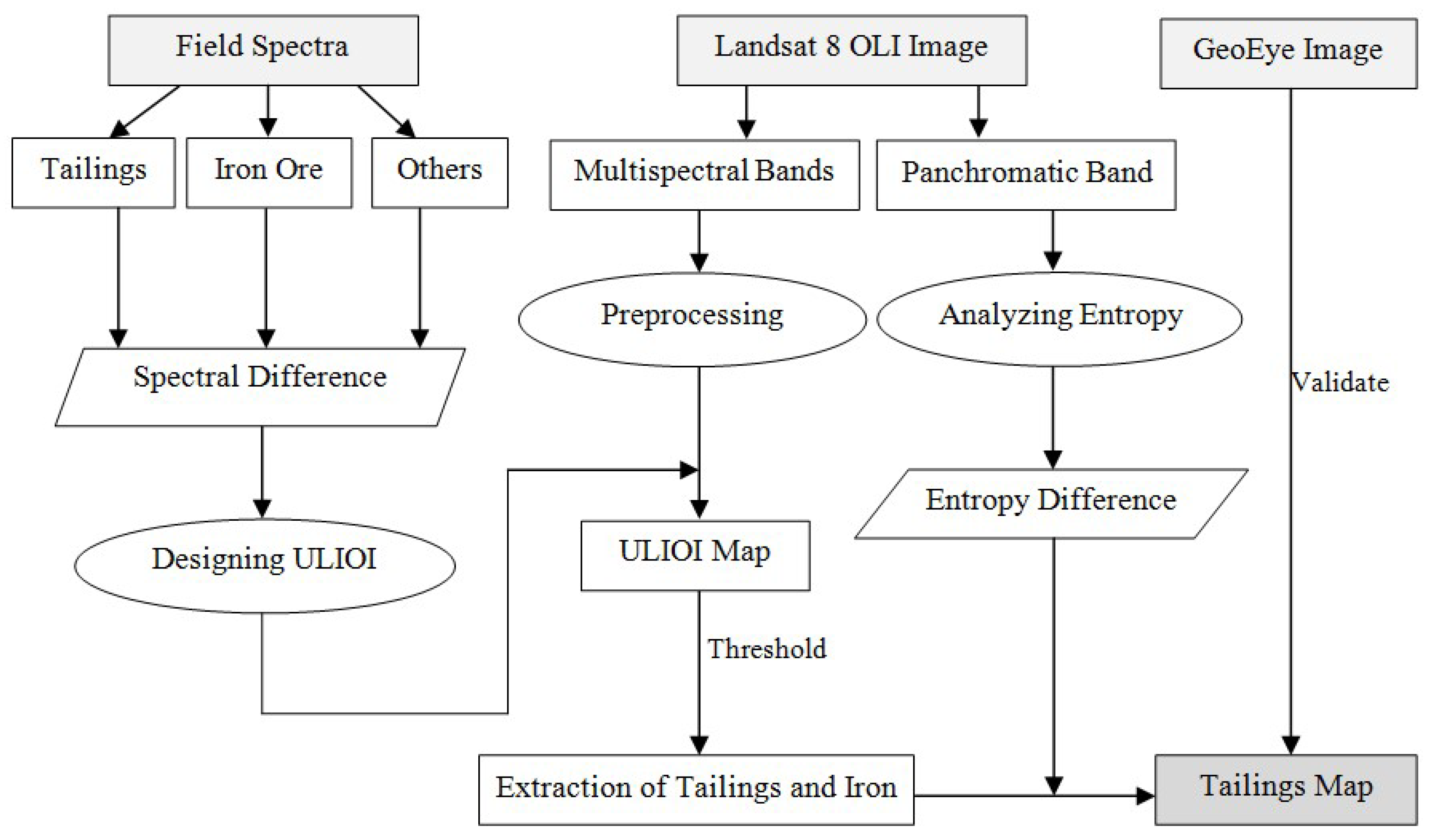
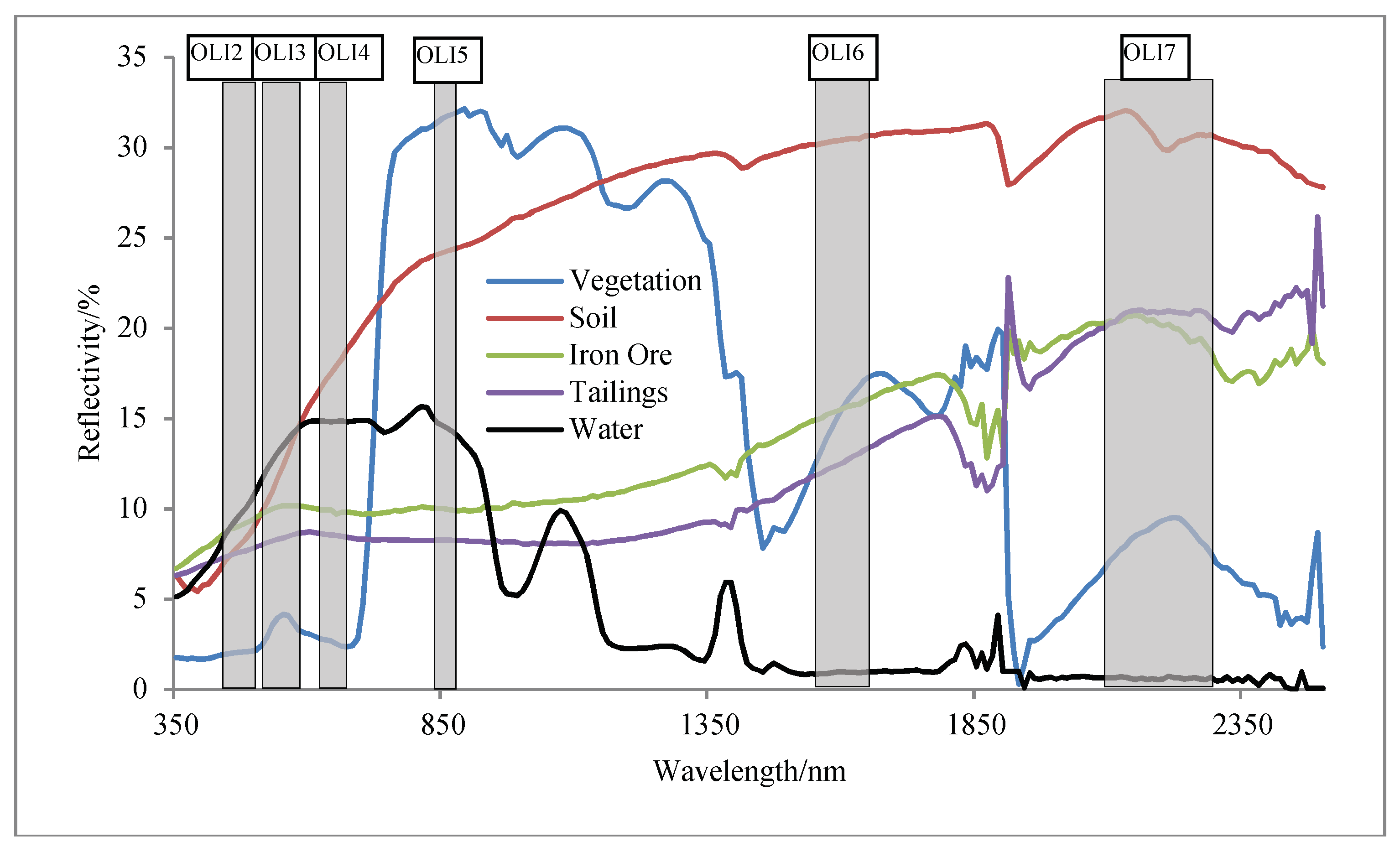
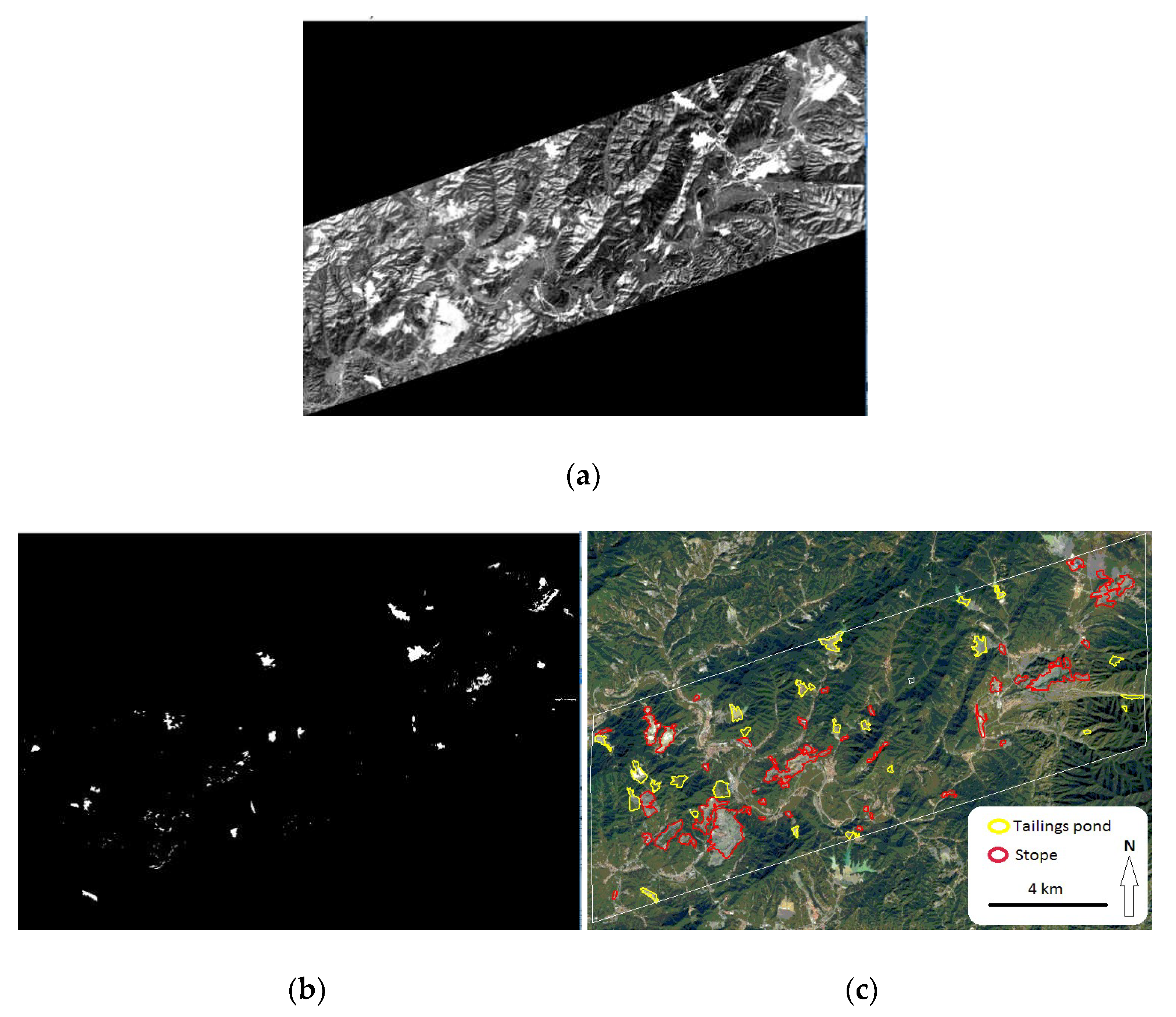
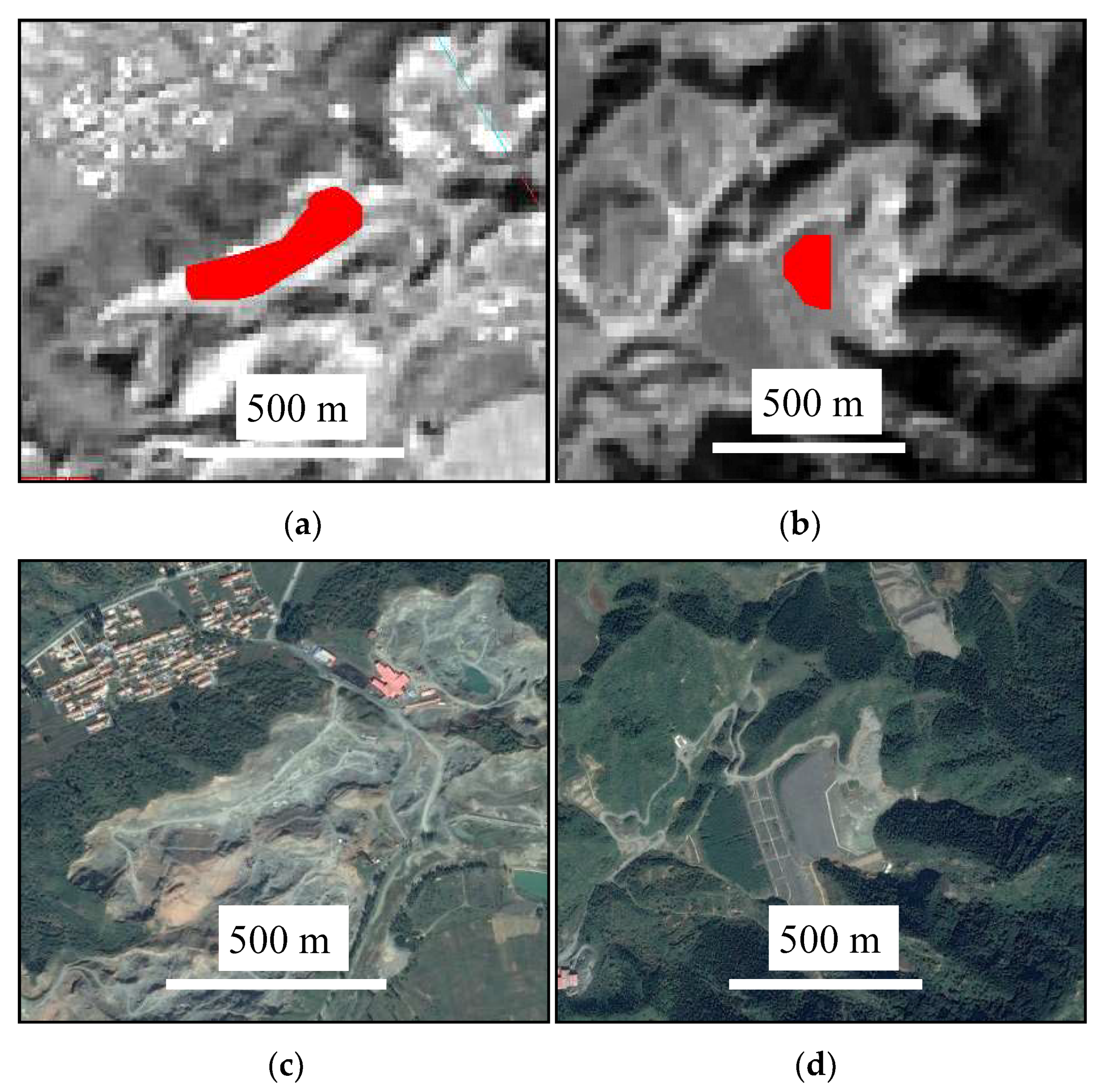


| Window Size | Tailings Pond | Stope | ||||||
|---|---|---|---|---|---|---|---|---|
| 0° | 45° | 90° | 135° | 0° | 45° | 90° | 135° | |
| 3 × 3 | 0.983 | 1.240 | 0.941 | 0.980 | 1.941 | 1.981 | 1.969 | 1.961 |
| 5 × 5 | 1.500 | 1.651 | 1.389 | 1.520 | 2.741 | 2.785 | 2.780 | 2.777 |
| 7 × 7 | 1.883 | 1.897 | 1.740 | 1.905 | 3.213 | 3.257 | 3.262 | 3.307 |
| 9 × 9 | 2.213 | 2.163 | 2.066 | 2.255 | 3.531 | 3.595 | 3.606 | 3.686 |
| 11 × 11 | 2.514 | 2.434 | 2.380 | 2.577 | 3.766 | 3.844 | 3.871 | 3.978 |
© 2018 by the authors. Licensee MDPI, Basel, Switzerland. This article is an open access article distributed under the terms and conditions of the Creative Commons Attribution (CC BY) license (http://creativecommons.org/licenses/by/4.0/).
Share and Cite
Ma, B.; Chen, Y.; Zhang, S.; Li, X. Remote Sensing Extraction Method of Tailings Ponds in Ultra-Low-Grade Iron Mining Area Based on Spectral Characteristics and Texture Entropy. Entropy 2018, 20, 345. https://doi.org/10.3390/e20050345
Ma B, Chen Y, Zhang S, Li X. Remote Sensing Extraction Method of Tailings Ponds in Ultra-Low-Grade Iron Mining Area Based on Spectral Characteristics and Texture Entropy. Entropy. 2018; 20(5):345. https://doi.org/10.3390/e20050345
Chicago/Turabian StyleMa, Baodong, Yuteng Chen, Song Zhang, and Xuexin Li. 2018. "Remote Sensing Extraction Method of Tailings Ponds in Ultra-Low-Grade Iron Mining Area Based on Spectral Characteristics and Texture Entropy" Entropy 20, no. 5: 345. https://doi.org/10.3390/e20050345
APA StyleMa, B., Chen, Y., Zhang, S., & Li, X. (2018). Remote Sensing Extraction Method of Tailings Ponds in Ultra-Low-Grade Iron Mining Area Based on Spectral Characteristics and Texture Entropy. Entropy, 20(5), 345. https://doi.org/10.3390/e20050345




